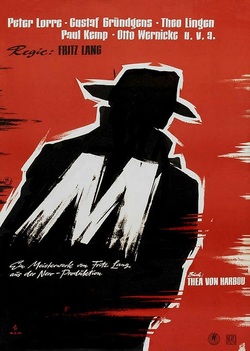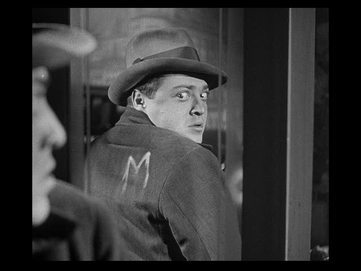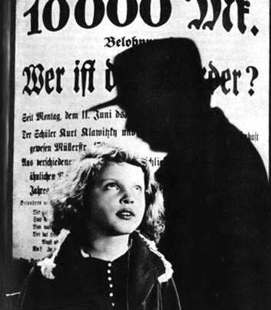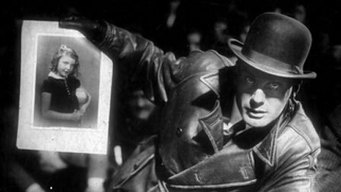
Experiment 626 (which may, or may not be Stitch's real name) is an event embarked on by the I'm With Geek Film Team. Film knowledge was unearthed, truths were found and a DVD exchange took place. These are the true life stories from that experiment...
For Jo from Hayley
M is the precursor to all of cinemas greatest anti-heroes and villain protagonists. It's lead, played brilliantly by Peter Lorre, is a child murderer, but what it examines is how society's witch hunts for criminals can often make them as evil as the criminal themselves. In that way, it's quite ahead of its time, considering the way tabloid newspapers whip up ill-informed hatred at every opportunity. Yes, the killer is an evil man, but he's not the only one capable of evil.

There are films from our past that audiences look back on with admiration. Their influence can range from helping to create a genre or for simply great storytelling. For some of these films, seminal as they may be, their appeal can fade outside their context. Many would argue that Citizen Kane is dull or that A Clockwork Orange is not really violent. In the case of Fritz Lang’s murder thriller M, its appeal and story have only bettered over time.
The film is set in a German city where a child murderer is on the loose. After another girl falls victim to the unknown man, police intensify their search for the killer. The man, a loner called Hans Beckert, (Peter Lorre) writes a letter of confession to a paper which when printed increases havok in the city. The polices increased presents prompts the criminal underworld in the city to undertake their own hunt for the man while he fights his dark impulses.
Fritz Lang had carved an impressive career shooting silent pictures before M. His other prominent film, Metropolis, was on its release the most expensive silent picture ever made. Supposdly inspired by the case of Peter Kurten known as The Vampire of Dusseldorf, although Lang denied this connection. He stated that although the film had been inspired by real crimes it was meant to be an allegory warning parents not to neglect their children. As well as being a great story and example of German expressionism the film stands as one of the later films to be produced free of Nazi influence.
As a story, the films appeal lies in it mystery and hunter aspects. The audience know the killers identity and travel with him as hes hunted down. The effect is claustrophobic and the audience feel the walls closing in. The story has an ambiguous moral centre to it. Instead of the police hunting down the killer its the criminal underworld that pursues him in M. The film also shows the darker side of vigilantly behaviour when the frightened public attack an innocent man simply for talking to a young girl.

Reflections and shadows also play a large part in Lang’s film. Characters are often seen in reflection from Berkert looking at himself in a mirror or seeing a potential victim in a shop window. The first time we see Berkerts character is in shadow form over the wanted poster for his capture. This hints at his inner turmoil and dark character.
Being that the film was made in 1931 it is shot in black and white. This however seems to enhance the dark mood of the film. Images seem heightened in monochrome such as the chalk white M planted on Beckert’s black coat. The imagery is more pronounced and powerful.
The really stand out technique that Lang used in the film is the omissions of disturbing scenes. Although the murders of children are featured in the plot, not one gruesome thing is seen. Lang builds the scene up creating dread then only suggests the violence. This is brilliantly demonstrated in the films opening scene. We see Beckert approach a young girl, buy her a balloon, then watch her ball roll away and her balloon become tangled in phone cables. Lang understands that each individual will fill in the horrific scene themselves with their own nightmarish imagination. A technique that modern film makers rearly use relying heavily on gore and special effects.

Peter Lorre, prior to M, had mainly been a comedic actor. His casting as Hans Beckert was his first leading role which he excels at. In Lorre’s portrayal, you have not simply an evil character but a man fighting his dark compulsion. You watch as Beckert tries to restrain his murderous needs only to fail. His round face and normal demeanor make him blend in as good predators do but in his eyes and expressive face Lorre demonstrates his acting ability.
The film acts as a character study into psychopathic tendencies. Films being produced in Hollywood at this time stuck to the moral code that good triumphs over evil and that stories should be told from the innocents perspective. Although the film chronicles Hans Beckert’s downfall it is his story. Lang has not only told the story from an immoral characters point of view but also dared to show him as vunrable and human.
A film that has truly earned its title as a classic. A thrilling tale expertly told through Lang’s poignant direction. First rate suspense with a brilliantly told story. Its no wonder that Lang himself considered M the best of his work.

 RSS Feed
RSS Feed
